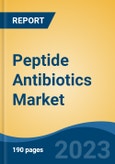Speak directly to the analyst to clarify any post sales queries you may have.
10% Free customizationThis report comes with 10% free customization, enabling you to add data that meets your specific business needs.
Their multi-targeted approach reduces the likelihood of bacterial resistance, a key advantage in an era marked by rising antimicrobial resistance. The growing prevalence of infections like Methicillin-resistant Staphylococcus aureus (MRSA), aging populations, increased surgical procedures, and enhanced peptide synthesis technologies are all contributing to the increased demand for these drugs. Moreover, peptide antibiotics are being increasingly used as part of stewardship programs and in prophylactic applications in healthcare, reinforcing their expanding role in modern infectious disease management.
Key Market Drivers
Advancements in Peptide Synthesis
Progress in solid-phase peptide synthesis (SPPS) has significantly enhanced the scalability and efficiency of peptide antibiotic production. Techniques such as the use of Fmoc and Boc protecting groups, multi-segment synthesis, and continuous-flow systems have streamlined complex peptide assembly. Automation has also become prevalent, enabling high-throughput synthesis with precision control. These technological innovations allow for cost-effective and rapid production of complex and stable peptides with enhanced bioactivity. Strategies like native chemical ligation and peptide cyclization further contribute to increased therapeutic efficacy and resistance to enzymatic degradation. Improvements in purification and conjugation methods, as well as the integration of peptides into nanoparticle systems, are expanding the applications of peptide antibiotics in targeted drug delivery and diagnostics, fueling their market expansion.Key Market Challenges
High Development Costs
The development of peptide antibiotics involves substantial investment across preclinical research, clinical trials, regulatory compliance, and large-scale manufacturing. Early-stage discovery and testing of new peptide candidates demand significant funding for laboratory infrastructure, skilled personnel, and animal studies. Clinical trials - particularly in later stages - incur major costs due to patient recruitment, monitoring, and data collection. Regulatory processes also impose strict requirements for demonstrating safety, efficacy, and quality, further adding to development expenses. Additionally, the cost of peptide production, especially at commercial scale, is elevated due to the complexity of synthesis, quality assurance protocols, and the need for specialized manufacturing equipment. Intellectual property management and ongoing pharmacovigilance activities also contribute to the financial burden, making cost a significant hurdle for widespread adoption.Key Market Trends
Growing Awareness of Antimicrobial Peptides (AMPs)
Antimicrobial peptides (AMPs) are gaining recognition for their broad-spectrum antimicrobial properties and unique mechanisms of action. Sourced from various organisms, AMPs target a wide range of pathogens and exhibit low resistance development potential. Their dual role in microbial eradication and immune modulation enhances their appeal in infectious disease treatment. The integration of AMPs with traditional antibiotics is being explored to improve therapeutic outcomes and limit resistance. Their application is also expanding into wound care and dermatology due to their healing properties. Increased R&D investment by pharmaceutical companies and a focus on developing AMP-based alternatives to conventional antibiotics reflect the market’s shift toward innovative and sustainable antimicrobial solutions.Key Players Profiled in this Peptide Antibiotics Market Report
- Pfizer Inc.
- Merck & Co., Inc.
- AbbVie Inc
- GSK Plc
- Sandoz International GmbH
- The Menarini Group
- Xellia Pharmaceuticals
- Novartis AG
- Teva Pharmaceutical Industries Ltd.
- AuroMedics Pharma LLC
Report Scope:
In this report, the Global Peptide Antibiotics Market has been segmented into the following categories, in addition to the industry trends which have also been detailed below:Peptide Antibiotics Market, by Type:
- Non-Ribosomal Synthesized Peptide Antibiotics
- Ribosomal Synthesized Peptide Antibiotics
Peptide Antibiotics Market, by Route of Administration:
- Injectable
- Oral
- Topical
Peptide Antibiotics Market, by Distribution Channel:
- Hospital Pharmacies
- Online Pharmacies
- Retail Pharmacies
Peptide Antibiotics Market, by Region:
- North America
- United States
- Canada
- Mexico
- Asia-Pacific
- China
- India
- South Korea
- Australia
- Japan
- Europe
- Germany
- France
- United Kingdom
- Spain
- Italy
- South America
- Brazil
- Argentina
- Colombia
- Middle East & Africa
- South Africa
- Saudi Arabia
- UAE
Competitive Landscape
Company Profiles: Detailed analysis of the major companies present in the Global Peptide Antibiotics Market.Available Customizations:
With the given market data, the publisher offers customizations according to a company's specific needs. The following customization options are available for the report.Company Information
- Detailed analysis and profiling of additional market players (up to five).
This product will be delivered within 1-3 business days.
Table of Contents
Companies Mentioned
The leading companies profiled in this Peptide Antibiotics market report include:- Pfizer Inc.
- Merck & Co., Inc.
- AbbVie Inc
- GSK Plc
- Sandoz International GmbH
- Novartis AG
- Xellia Pharmaceuticals
- Novartis AG
- Teva Pharmaceutical Industries Ltd.
- AuroMedics Pharma LLC
Table Information
| Report Attribute | Details |
|---|---|
| No. of Pages | 180 |
| Published | May 2025 |
| Forecast Period | 2024 - 2030 |
| Estimated Market Value ( USD | $ 5.17 Billion |
| Forecasted Market Value ( USD | $ 7.67 Billion |
| Compound Annual Growth Rate | 6.7% |
| Regions Covered | Global |
| No. of Companies Mentioned | 11 |









